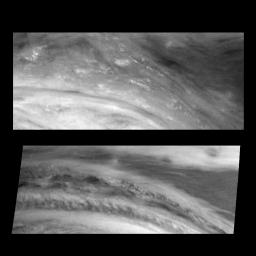
|
Changes in Jupiter’s Great Red Spot After Four Months
- Click the image above for a larger view
- Full-Res JPEG (1000 x 1000) (76.0 kB)
- Full-Res TIFF (1000 x 1000) (474.2 kB)
Caption:
Northeast (upper right) quadrant of Jupiter's Great Red Spot in June and November 1996. The top panel shows the region in near-infrared light (732 nanometers) on June 26, 1996. The bottom panel shows the same region at 757 nanometers on November 5, 1996. Both images show features in Jupiter's main visible cloud deck. A westward (to the left) jet is deflected northward by the Great Red Spot in this region. Cloud features, possibly including thunderstorms, were actively changing during the June encounter. The deflection around the Red Spot appears to be less during the November encounter. Small thunderstorm-like clouds are once again present. The bottom image was taken with the high resolution mode of the camera that allows features twice as small to be detected.
North is at the top. The images are approximately 6000 kilometers from north to south and 15,000 kilometers from east to west. They are centered at 14 degrees latitude and 314 and 353 degrees west longitude, respectively. The smallest resolved features are tens of kilometers in size. These images were taken by the Solid State Imaging system aboard NASA's Galileo spacecraft.
Background Info:
The Jet Propulsion Laboratory, Pasadena, CA manages the mission for NASA's Office of Space Science, Washington, DC.
This image and other images and data received from Galileo are posted on the World Wide Web, on the Galileo mission home page at URL http://galileo.jpl.nasa.gov. Background information and educational context for the images can be found at http://www.jpl.nasa.gov/galileo/sepo .
Cataloging Keywords:
| Name | Value | Additional Values |
|---|---|---|
| Target | Jupiter | |
| System | Jupiter | |
| Target Type | Planet | |
| Mission | Galileo | |
| Instrument Host | Galileo Orbiter | |
| Host Type | Orbiter | |
| Instrument | Solid-State Imaging (SSI) | |
| Detector | ||
| Extra Keywords | Atmosphere, Grayscale, Infrared, Storm | |
| Acquisition Date | ||
| Release Date | 1997-12-18 | |
| Date in Caption | 1996-06-26 | 1996-11-05 |
| Image Credit | NASA/JPL-Caltech | |
| Source | photojournal.jpl.nasa.gov/catalog/PIA01119 | |
| Identifier | PIA01119 | |
